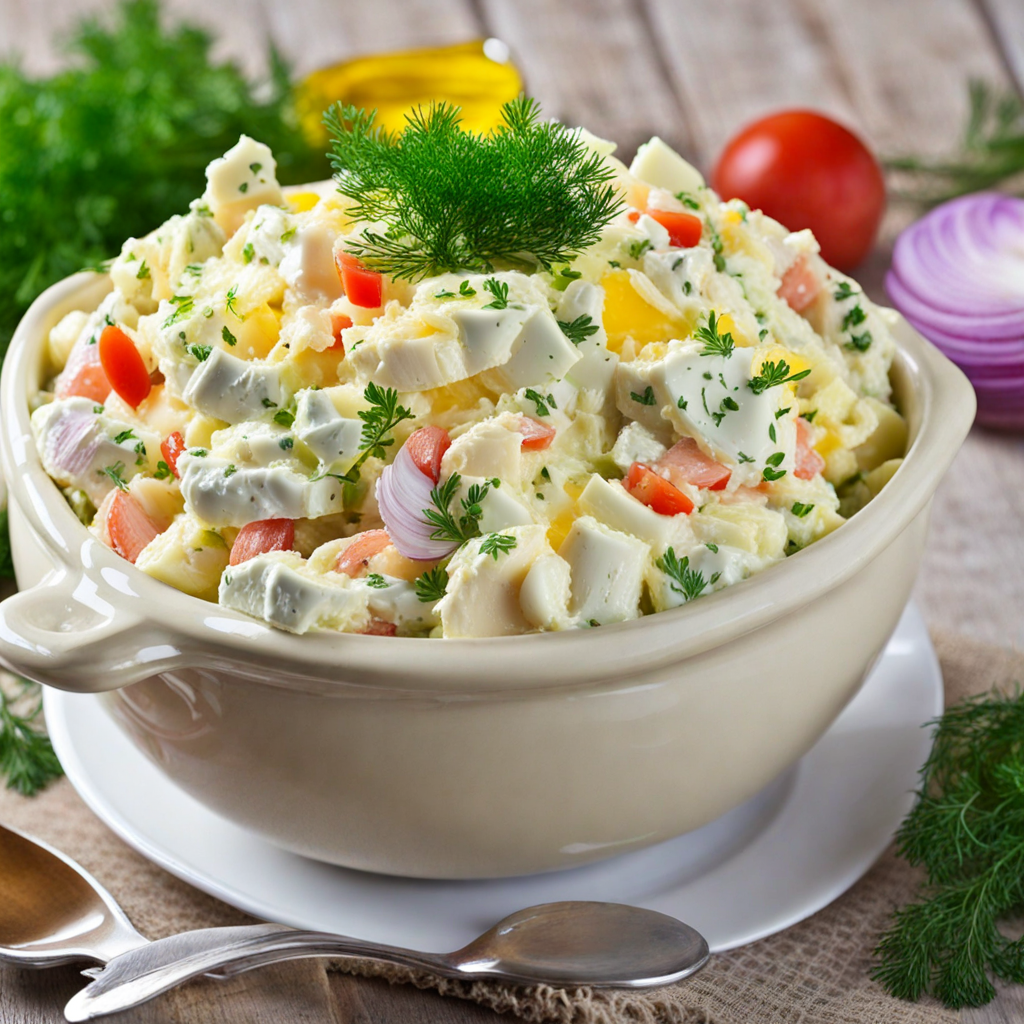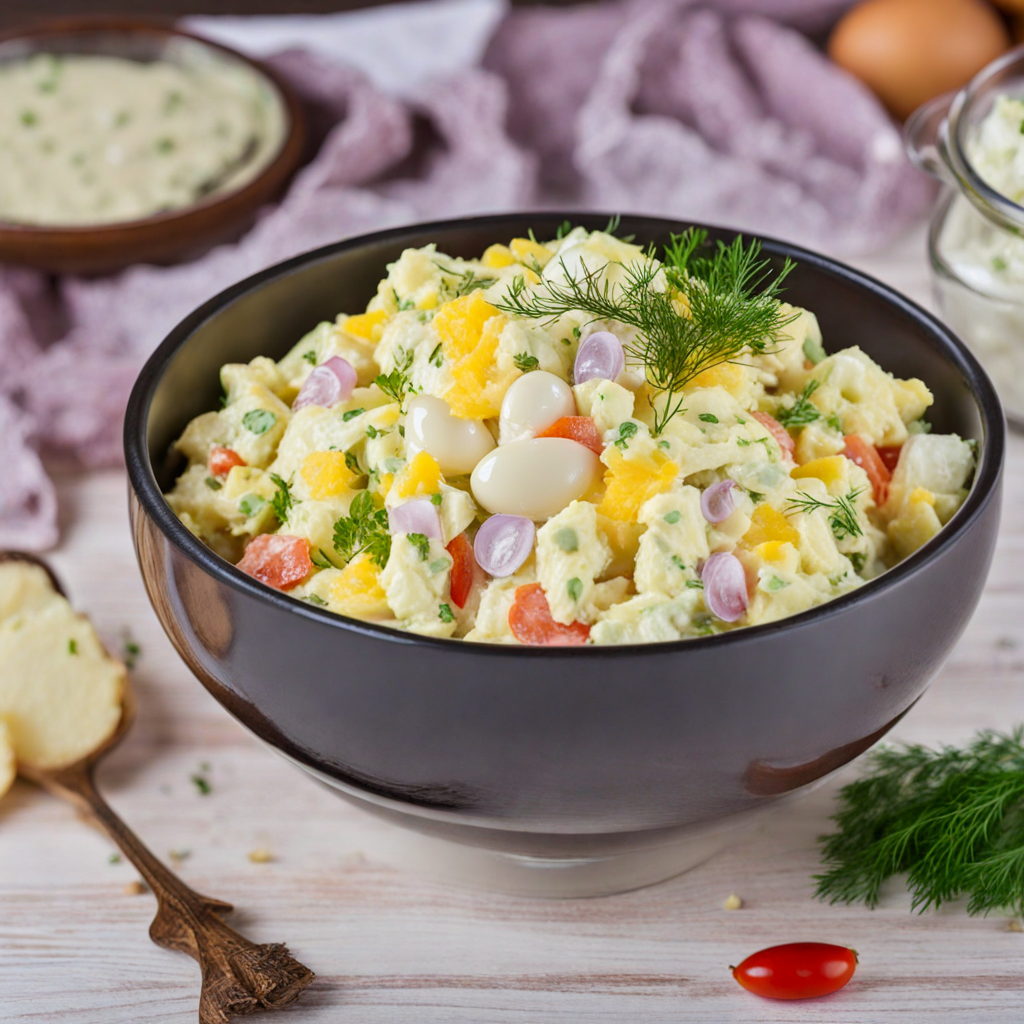Olivier Salad
Olivier Salad, also known as Russian Salad, is a beloved dish that hails from Ukraine and has gained popularity across Eastern Europe. This hearty and colorful salad is a delightful medley of ingredients that typically includes diced boiled potatoes, carrots, peas, pickles, and boiled eggs. The addition of tender meat, such as chicken or bologna, lends a savory richness to the mix. Each ingredient is carefully chopped into uniform pieces, creating an appealing texture and vibrant appearance that invites you to dig in. The beauty of Olivier Salad lies in its versatility, as home cooks often adapt the recipe by incorporating their favorite components, making it a personal culinary expression. The dressing is a crucial element of Olivier Salad, usually made from a creamy mayonnaise base, which adds a luxurious, tangy flavor that ties all the ingredients together. Some variations might include mustard or sour cream to enhance the taste further. The resulting combination of creamy and crunchy textures, along with the robust flavors from the vegetables and meat, creates a satisfying dish that is both filling and refreshing. Served chilled, Olivier Salad is a delightful addition to any festive table, often featured during celebrations, holidays, or family gatherings, where it brings a sense of nostalgia and comfort. Enjoying Olivier Salad is not just about savoring its taste; it's also about experiencing a slice of Ukrainian culture. Each bite tells a story of tradition, where generations have passed down recipes and variations, making it a cherished part of communal meals. Whether enjoyed as a side dish or a main course, Olivier Salad offers a unique culinary adventure that combines familiar ingredients in an exciting way. Its rich history and adaptability make it a must-try for anyone eager to explore the flavors of Ukrainian cuisine.
How It Became This Dish
Салат Олів'є: A Culinary Journey Through Time Origins of Салат Олів'є Салат Олів'є, known to many simply as "Olivier Salad," is one of the most iconic dishes in Ukrainian cuisine, with roots that stretch back to the 19th century. Its creation is attributed to the French chef Lucien Olivier, who worked at the famous Hermitage restaurant in Moscow during the 1860s. Olivier's original recipe was a lavish salad that featured gourmet ingredients such as game meats, caviar, and a variety of exotic vegetables, all bound together with a rich sauce made from mayonnaise and mustard. The salad was a reflection of the opulence of the Russian aristocracy, showcasing the culinary influences of both French cuisine and the abundant resources available in the region. The Cultural Significance of Салат Олів'є As the years passed, Салат Олів'є transitioned from a dish enjoyed by the elite to a staple in Russian and Ukrainian households, especially during festive occasions. Its popularity surged during the Soviet era, when it became a symbol of celebration and communal gatherings. The salad is a quintessential part of New Year’s feasts, birthday parties, and holiday banquets across Ukraine and beyond. The cultural significance of Салат Олів'є lies in its ability to bring people together. Regardless of its opulent origins, it has become a dish that embodies the spirit of home-cooked meals and family gatherings. The act of preparing the salad, often a collaborative effort among family members, fosters a sense of community and tradition. Each family tends to have its own version of the recipe, passed down through generations, reflecting regional variations and personal preferences. Development Over Time The transformation of Салат Олів'є from its aristocratic roots to a beloved dish in Ukrainian households can be attributed to several social and economic changes throughout the 20th century. With the Russian Revolution and the subsequent establishment of the Soviet Union, the once-elite dish became more accessible to the general populace. The original recipe was adapted to fit the realities of Soviet life, where luxury ingredients were often hard to come by. As a result, the classic ingredients of Салат Олів'є underwent significant modifications. The original game meats were often replaced with more readily available components, such as boiled chicken or ham. The use of fresh vegetables like peas, carrots, and pickles became common, as these ingredients were affordable and easily preserved. The mayonnaise, which had been a luxury, became a staple condiment, often homemade or purchased in bulk from state-run stores. In the post-Soviet era, the salad continued to evolve. As Ukraine gained independence in 1991, there was a renewed interest in national identity and heritage, which influenced the culinary landscape. While Салат Олів'є remained a popular dish, chefs began to experiment with it, adding modern twists and new ingredients. Variations emerged that incorporated flavors from other cuisines, reflecting the globalized world in which people were now living. The Recipe: A Classic and Its Variations The traditional Салат Олів'є is characterized by its creamy texture and colorful presentation. The classic recipe typically includes boiled potatoes, carrots, peas, dill pickles, boiled eggs, and a protein source like chicken or ham. All the ingredients are diced into small cubes and mixed with mayonnaise, creating a rich and satisfying dish. Some variations might include ingredients such as apples for sweetness, or even fish like tuna, depending on personal preferences and regional availability. In contemporary Ukraine, it is common to see Салат Олів'є served at weddings, birthdays, and especially during the New Year celebrations, alongside other traditional dishes. The salad is often presented on a large platter, garnished with fresh herbs, and sometimes decorated to depict seasonal themes or festive motifs. The Global Reach of Салат Олів'є In recent years, Салат Олів'є has transcended its Ukrainian roots and found a place in the culinary culture of various countries, particularly in former Soviet states. In Russia, it is still known as "Olivier Salad," while in other countries, it may be referred to by different names but retains its essence. Chefs and home cooks alike have embraced the dish, recognizing its ability to adapt to local tastes and ingredients. The salad’s popularity has also spread to international culinary events, where it is often featured as an exotic dish that represents Eastern European cuisine. Food enthusiasts appreciate not only its flavor but also the history and cultural significance that it embodies. Conclusion Салат Олів'є is more than just a salad; it is a culinary symbol of resilience, adaptation, and community. Its journey from the opulent tables of 19th-century Moscow to the heart of Ukrainian households is a testament to the rich tapestry of cultural exchange that defines food history. As it continues to evolve, Салат Олів'є remains a beloved dish that connects generations, celebrates traditions, and invites everyone to the table. Whether served at a festive gathering or enjoyed as a simple meal at home, Салат Олів'є tells a story of heritage, creativity, and the enduring power of food to unite people across time and space.
You may like
Discover local flavors from Ukraine







